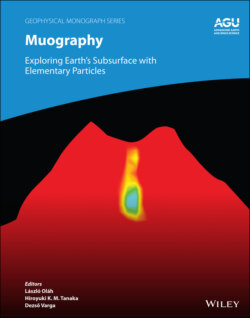Читать книгу Muography - Группа авторов - Страница 16
1.2.1 Muon Energy Spectrum
ОглавлениеMuons are produced during the interaction between primary GCRs and the nuclei in the planet’s atmosphere or within rocks if there is no atmosphere. These muons are called cosmic‐ray muons. An expression for the differential cosmic‐ray muon spectrum on Earth at various zenith angles has been derived by several authors in accordance with the hypothesis that the primary particles are isotropically incident at the top of the atmosphere, and that the mesons (pions and kaons) retain the directions of their producers (Bull et al., 1965; Bugaev et al., 1998; Gaisser & Stanev, 2008; Matsuno et al., 1984). These authors' analytical expressions have been validated and improved by comparison with the spectrum of muons taken from experiments performed at sea level (Achard et al., 2004; Allkofer et al., 1985; Haino et al., 2004; Jokisch et al., 1979; Matsuno et al., 1984), and the current expression is in good agreement with the observed muon flux. On Earth, the muon flux reaches its maximum (~200 1/m2/sr/s) at an atmospheric depth of approximately 300 g/cm2, depending on the latitude, and then slowly decreases as the muons pass through the additional atmospheric depth (Particle Data Group, 2020). The muon flux is ~90 1/m2/sr/s at sea level. The horizontal muon rate on Earth is suppressed compared to the vertical muons mainly due to the increased atmospheric path length and correspondingly higher energy cutoff. Furthermore, the average charged pion multiplicity is different. There is an appreciable probability that (higher energy) pions will collide with atmospheric nuclei before decaying into muons, and (lower energy) muons decay before reaching the Earth’s surface. However, the average muon energy becomes increasingly high as the direction traveled is more horizontal because pions decay before they re‐interact any further. While the decay constant of muons is 660 m, those of pions and kaons are much shorter, and respectively 7.8 m and 3.7 m.
On Mars, the surface atmospheric pressure is only ~1/100 that of the Earth, and thus, many of the primary particles reach the surface before undergoing a primary interaction. This results in both a lower meson production rate and a lower meson decay rate than in the Earth’s atmosphere. Tanaka (2007) indicated that based on the steep power law dependence in the early stages of the shower cascade, the meson flux would be strongly dependent on the atmospheric pressure, zenith angle, and muon energy. On Mars, the horizontal muon rate is higher than the vertical muon rate due to the additional atmospheric mass through which the muons transverse. The horizontal atmospheric depth of Mars is 100 g/cm2, a sufficient number of mesons. A sufficient number of muons to be practically detectable on the Martian surface are generated in the horizontal direction, and their energies are sufficiently high to practically perform muography on Mars. Muography can be performed because the probability of the decay of mesons before further interactions is higher than it would be on Earth; this is in stark contrast to the muon generation on Earth.
On small stellar bodies (SSB) such as asteroids or comets, there is no atmosphere. Primary GCRs directly collide with the stellar bodies and generate muons inside them. The average energy of these muons is much lower than the atmospheric muons because the secondary mesons are more copiously produced due to the short mean free path (MFP) inside solid‐state materials and thus, their energies are quickly dissipated. The resultant muon flux (> 50 GeV) is 103–104 times lower than the terrestrial muon flux, depending on the medium density (Prettyman et al., 2014). This flux has a tendency to decrease as a medium density increases because the meson’s MFP is further shortened. Currently, the application of muography to extraterrestrial objects is still in the conceptual phase.
